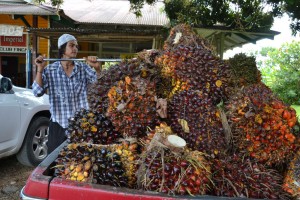We Certainly Didn’t Kill Any Orangutans
Most of our clients at Hacienda Baru Lodge come here by way of the coastal highway which takes them through all of the oil palm plantations beginning in Parrita and extending a total of 40 kilometers all the way to Portalón to the south of Quepos. I often hear comments such as; “Aren’t all of those oil palms horrible. I hear they are really bad for the environment, and somebody told me that palm oil causes all kinds of health problems.” In recent years oil palms and palm oil have gotten a lot of bad press and an extremely bad reputation, some of which is deserved and some of which isn’t.
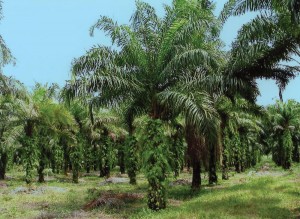
If you Google “Oil Palm Plantations” many of the sites you reach will be about the demise of the orangutan due to expanding deforestation in Indonesia and Malaysia. During the decade from 2000 to 2010 an average of nearly one-half million hectares (1,235,000 acres) of orangutan rainforest habitat was destroyed each year. The total area dedicated to palm oil production in those two countries is now upwards of 8 million hectares (20 million acres). If the deforestation continues it could very well bring about the extinction of these large, charismatic primates in the not too distant future.
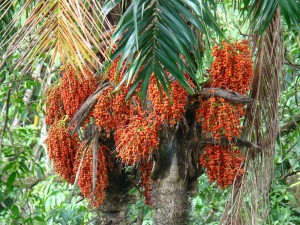
So why are Indonesia and Malaysia so obsessed with producing palm oil? As you may have guessed, it is a very profitable business. Up until a couple of years ago oil palm was the second largest source of vegetable oil in the world, right behind soybeans. The trees begin to produce the oil bearing palm fruits within 2-3 years of planting. Several years later they reach full production and can produce for up to 30 years. A plantation in full production can yield up to 30 metric tons of fruit per hectare per year. Each hectare (2.47 acres) of oil palm will produce up to 10 times more oil than one hectare of soybeans. “If this is so,” you might ask, “why does anyone continue to grow soybeans?” Illinois is the largest soybean oil producing state in the US. If Illinois farmers could grow oil palms they probably would, but outside of a greenhouse your aren’t likely to see any palm trees in Illinois. They don’t do well in most of China either, and China is the world’s largest soybean producing country.
USDA estimates for 2014 show that Indonesia and Malaysia combined will produce 55,000,000 metric tons of palm oil, more than all the rest of the world combined and more than the entire world’s production of soybean oil. We are talking about a $40 billion per year business which is growing rapidly and consuming orangutan inhabited rainforest as it does so. Is it any wonder that palm oil production has a bad name?
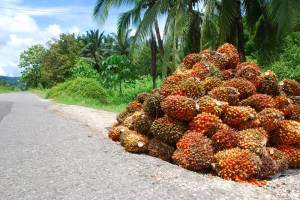
Oil palm trees produce large clusters of palm fruit, each weighing as much as 100 pounds and containing 1000 or more fruits. Each fruit has a kernel or seed in the center. This is covered with a fleshy pulp, and the entire fruit is enclosed in a thin fibrous outer skin. Both the pulp and the kernel are rich in oil. The oil produced from the pulp is rich in carotene which gives it a reddish color. Some sources say that it contains 16 times more carotene than carrots. This oil is high in saturated fats and is therefore solid at room temperature. For this reason it is ideal for products such as margarine and certain cosmetics.
According to USDA estimates Costa Rica will produce 270,000 metric tons of palm oil in 2014, making it the 10th largest producer in the world. It is possible that some rainforest was cut to make way for oil palm in this country, but, if so, it was done illegally. The land now occupied by the plantations in the Quepos-Parrita area was cleared for bananas many years before anyone in Costa Rica ever heard of oil palm.
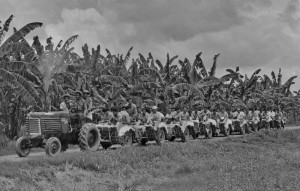
Don Oscar Monge Maykall, in his wonderful book La Historia Real de Quepos, recounts the history of banana production in Costa Rica. It all started in 1870 when fishing boat Capitan Lorenzo Dow Baker bought 160 bunches of bananas in Jamaica for one schilling each and took them to Boston where he sold them for $2 each. This strange new fruit rapidly became popular in the United States, and the demand soon exceeded the supply. Dow Baker partnered with Boston businessman Andrew Preston to develop a market for bananas in Boston. The partnership prospered and in 1885 they took on 10 new partners and founded the Boston Fruit Company. The business grew with the demand, and by 1998 a total of 16 million bunches of bananas were imported into the United States, and the market was demanding more. In 1899 the Boston Fruit Company merged with several companies owned by industrialist Minor Keith who had spent the previous decade building a railroad from Port Limon to San Jose in Costa Rica. The United Fruit Company was born of this merger. The company bought land throughout the Caribbean, Colombia, and Central America for the production of bananas. Keith received concessions on large tracts of land along the railroad. These he cleared and planted to bananas. By 1908 about 14,500 hectares (34,000 acres) of bananas had been planted on the Caribbean side of Costa Rica. A devastating fungus called “Panama Disease” and later another disease called Sigatoka destroyed so many banana plantations that by 1931 only 3,500 hectares remained.
In 1923 investor Agathon Lutz Stiegle surmised that the Central Pacific coast might meet the requirements for growing bananas. The annual rainfall is about the same as the Caribbean side of the country, but there is a well defined dry season during the first three months of each year. Perhaps this type of climate would help control the fungus. He acquired and cleared some land near Parrita and began growing bananas. The experiment was successful, and Lutz continued to acquire and clear land on which to cultivate bananas. A small port was built in Quepos to facilitate shipping, and the bananas were transported from the plantations to the port on rails with carts pulled by mules and horses. In Spanish a railroad is a “ferrocarril, but this form of transportation they called the “burrocarril.”
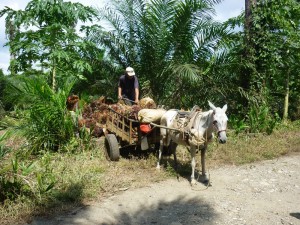
In 1934 the United Fruit Company acquired Agathon Lutz’ extensive holdings and continued acquiring land and expanding banana production. A larger, better equipped port was built in Quepos and began operating in 1939. All during the 1940s land was acquired, cleared and planted to bananas. A narrow-gauge railroad was built to transport the bananas from the plantations to the port. It extended all the way to the village of Portalón to the southeast of Quepos. People from all over Costa Rica and Nicaragua migrated to the area to work in the plantations. The area prospered.
In 1954 torrential rains caused rivers to overflow their banks and flood the United Fruit Company’s banana plantations. Those that were destroyed by the floods were replanted, but were destroyed again the following year when even more devastating torrential rains flooded even more area. The railroad bridge over the Savegre River was carried away by the flood waters. The extremely humid conditions created by the floods enhanced the growth of the the same fungal diseases that had devastated the banana plantations on the Caribbean side of the country earlier in the century. This brought an end to the production of this extremely popular fruit in the Quepos-Parrita area.
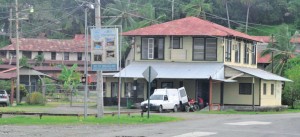
The United Fruit Company had been experimenting with oil palms for a number of years and decided to try planting them in the Quepos area. The palm plantations did well, and the production of palm oil was profitable. In the 1990s the operation was acquired by a company called Palma Tica, a subsidiary of Chiquita Banana, formerly United Fruit Company. Palma Tica is now part of the Numar Group. They have been successful in producing palm oil throughout Costa Rica. They have developed several hybrid varieties of oil palms that don’t grow as tall as original species planted. This greatly facilitates harvesting.
I have heard a few comments that palm oil is bad for your health. Whenever anybody tells me that something is bad for my health I always remember the big cranberry scare in the mid 1970s. The USDA warned the public that many cranberry producers had used a chemical that causes cancer. This information was released in the fall just before the holidays when cranberry sauce has always been a traditional part every Thanksgiving and Christmas dinner. Most of the crop rotted as the public broke with tradition and did without the delicious, red fruit for the holidays. Needless to say, quite a few cranberry producers filed for bankruptcy. Several months after the holidays all of the science on the matter was completed. The results showed that if a person ate two tons of cranberries a day for a couple of years there was a 50% chance that they would develop cancer. Since that time I don’t worry much when people tell me something is bad for my health.
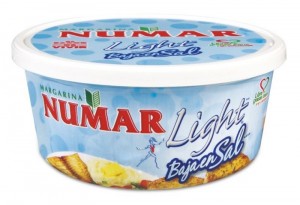
Palm oil is high in saturated fats and may cause cholesterol levels to rise more than other vegetable oils do. However the adverse effect is much less than with meat and dairy products. Anyone who has had problems with high cholesterol should think twice before switching from margarine, made with palm oil, to butter.
It has been said that oil palms are bad for the environment. This is certainly true, but any agriculture other than pure organic farming is going to have some negative impact on the environment. Most of the arable land in this area is either planted to oil palms or rice, and I believe that rice production is far worse for the environment and the palms. Of course many of us would prefer natural rainforest to any kind of agriculture, but we must recognize that there are seven billion people in the world, and they all have to eat. As long as there is a need for vegetable oil in peoples diets, oil palms are likely to be around. Most of the plantations in Costa Rica were planted on land that was previously dedicated to some kind of farming. Rainforest was not sacrificed to make way for the palms, and we certainly didn’t kill any orangutans.

